《概率论与数理统计》课程教学资源(教案讲义)Chapter 1 Random Events and Probability
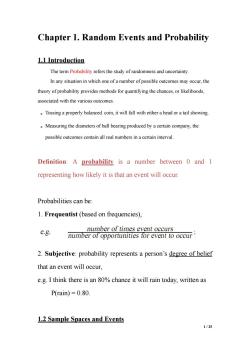
Chapter 1.Random Events and Probability 1.1 Introduction The term Probability refers the study of randomness and uncertainty. In any situation in which one of a number of possible outcomes may occur,the theory of probability provides methods for quantifying the chances,or likelihoods, associated with the various outcomes. Tossing a properly balanced coin,it will fall with either a head or a tail showing. Measuring the diameters of ball bearing produced by a certain company,the possible outcomes contain all real numbers in a certain interval Definition:A probability is a number between 0 and 1 representing how likely it is that an event will occur. Probabilities can be: 1.Frequentist(based on frequencies), number of times event occurs e.g. number of opportunities for event to occur 2.Subjeetive:probability represents a person's degree of belief that an event will occur, e.g.I think there is an 80%chance it will rain today,written as P(rain)=0.80 1.2 Sample Spaces and Events 1/25
1 / 25 Chapter 1. Random Events and Probability 1.1 Introduction The term Probability refers the study of randomness and uncertainty. In any situation in which one of a number of possible outcomes may occur, the theory of probability provides methods for quantifying the chances, or likelihoods, associated with the various outcomes. 。Tossing a properly balanced coin, it will fall with either a head or a tail showing. 。Measuring the diameters of ball bearing produced by a certain company, the possible outcomes contain all real numbers in a certain interval. Definition: A probability is a number between 0 and 1 representing how likely it is that an event will occur. Probabilities can be: 1. Frequentist (based on frequencies), 2. Subjective: probability represents a person’s degree of belief that an event will occur, e.g. I think there is an 80% chance it will rain today, written as P(rain) = 0.80. 1.2 Sample Spaces and Events
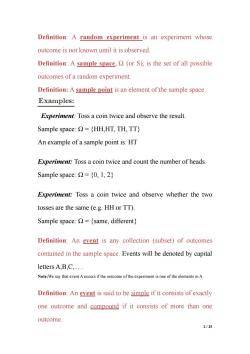
Definition:A random experiment is an experiment whose outcome is not known until it is observed. Definition:A sample space,(or S),is the set of all possible outcomes of a random experiment. Definition:A sample point is an element of the sample space. Examples: Experiment:Toss a coin twice and observe the result. Sample space:{HH,HT.TH.TT} An example of a sample point is:HT Experiment:Toss a coin twice and count the number of heads. Sample space:={0,1,2) Experiment:Toss a coin twice and observe whether the two tosses are the same(e.g.HH or TT). Sample space:={same,different) Definition:An event is any collection (subset)of outcomes contained in the sample space.Events will be denoted by capital letters A.B.C,.... Note:We say that event Aoccurs if the outcome of the experiment is one of the elements in A. Definition:An event is said to be simple if it consists of exactly one outcome and compound if it consists of more than one outcome 2125
2 / 25 Definition: A random experiment is an experiment whose outcome is not known until it is observed. Definition: A sample space, Ω (or S), is the set of all possible outcomes of a random experiment. Definition: A sample point is an element of the sample space. Experiment: Toss a coin twice and observe the result. Sample space: Ω = {HH,HT, TH, TT} An example of a sample point is: HT Experiment: Toss a coin twice and count the number of heads. Sample space: Ω = {0, 1, 2} Experiment: Toss a coin twice and observe whether the two tosses are the same (e.g. HH or TT). Sample space: Ω = {same, different} Definition: An event is any collection (subset) of outcomes contained in the sample space. Events will be denoted by capital letters A,B,C,... . Note:We say that event A occurs if the outcome of the experiment is one of the elements in A. Definition: An event is said to be simple if it consists of exactly one outcome and compound if it consists of more than one outcome

Example:Toss a coin twice Sample space:(HH,HT,TH,TT) Let event a be the event that there is exactly one head. We write:A="exactly one head" Then A=(HT,TH). Note:A is a subset of as in the definition.We write A C Definition:Event A occurs if we observe an outcome that is a member of the set A Note:Q is a subset of itself,so is an event.The empty set, =is also a subset of.This is called the empty set (or null event),or the event with no outcomes. Example:Experiment:throw 2 dice. Sample space:2={(1,1),(1,2),..,(1,6),(2,1),(2,2),.., (2,6),..,(6,6)} Event A="sum of two faces is 5"=((1,4),(2,3),(3,2),(4,1)) Example:Consider an experiment in which each of three automobiles taking a particular freeway exit turns Left(L)or right(R)at the end of the exit ramp. The eight possible outcomes that comprise the sample space are 3125
3 / 25 Example: Toss a coin twice. Sample space: Ω = {HH,HT, TH, TT} Let event A be the event that there is exactly one head. We write: A =“exactly one head” Then A = {HT, TH}. Note:A is a subset of Ω, as in the definition. We write A ⊂ Ω. Definition: Event A occurs if we observe an outcome that is a member of the set A. Note: Ω is a subset of itself, so Ω is an event. The empty set, φ = {}, is also a subset of Ω. This is called the empty set (or null event), or the event with no outcomes. Example: Experiment: throw 2 dice. Sample space: Ω = {(1, 1), (1, 2), . . . , (1, 6), (2, 1), (2, 2), . . . , (2, 6), . . . , (6, 6)} Event A = “sum of two faces is 5” = {(1, 4), (2, 3), (3, 2), (4, 1)} Example: Consider an experiment in which each of three automobiles taking a particular freeway exit turns Left(L) or right (R) at the end of the exit ramp. The eight possible outcomes that comprise the sample space are
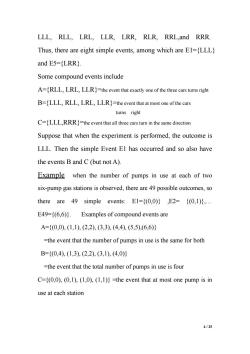
LLL,RLL,LRL,LLR,LRR,RLR,RRL,and RRR Thus,there are eight simple events,among which are El=(LLL} and E5=LRR). Some compound events include A={RLL,LRL,LLR)=the event that exactly one of the three cars turns right B=LLL,RLL,LRL,LLR)=the event that at most one of the cars turns right C=LLL,RRR)=the event that all three cars turn in the same direction Suppose that when the experiment is performed,the outcome is LLL.Then the simple Event EI has occurred and so also have the events B and C (but not A). Example when the number of pumps in use at each of two six-pump gas stations is observed,there are 49 possible outcomes,so there are 49 simple events:E1=(0,0)),E2={(0,1)),... E49=(6,6)).Examples of compound events are A={(0,0),(1,1),(2,2)(3,3),(4,4),(5,5),(6,6)} =the event that the number of pumps in use is the same for both B={(0,4),(1,3),(2,2),(3,1),(4,0)} =the event that the total number of pumps in use is four C=(0,0),(0,1),(1,0),(1,1);=the event that at most one pump is in use at each station 4/25
4 / 25 LLL, RLL, LRL, LLR, LRR, RLR, RRL,and RRR. Thus, there are eight simple events, among which are E1={LLL} and E5={LRR}. Some compound events include A={RLL, LRL, LLR}=the event that exactly one of the three cars turns right B={LLL, RLL, LRL, LLR}=the event that at most one of the cars turns right C={LLL,RRR}=the event that all three cars turn in the same direction Suppose that when the experiment is performed, the outcome is LLL. Then the simple Event E1 has occurred and so also have the events B and C (but not A). Example when the number of pumps in use at each of two six-pump gas stations is observed, there are 49 possible outcomes, so there are 49 simple events: E1={(0,0)} ,E2= {(0,1)},… E49={(6,6)}. Examples of compound events are A={(0,0), (1,1), (2,2), (3,3), (4,4), (5,5),(6,6)} =the event that the number of pumps in use is the same for both B={(0,4), (1,3), (2,2), (3,1), (4,0)} =the event that the total number of pumps in use is four C={(0,0), (0,1), (1,0), (1,1)} =the event that at most one pump is in use at each station
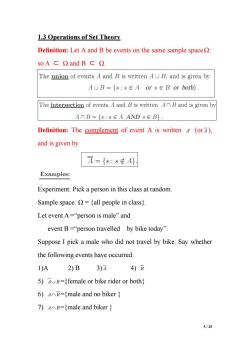
1.3 Operations of Set Theory Definition:Let A and B be events on the same sample space: soAcΩand B CΩ. The union of events A and B is written AUB,and is given by AUB={s:s∈Aors∈B or both} The intersection of events A and B is written AnB and is given by A∩B={s:s∈A AND s∈B}. Definition:The complement of event A is written(or), and is given by 万={s:s年A} Examples: Experiment:Pick a person in this class at random. Sample space:fall people in class) Let event A=“person is male'”and event B=“person travelled by bike today”. Suppose I pick a male who did not travel by bike.Say whether the following events have occurred: 1)A2)B3)A 4)B 5)AB=female or bike rider or both) 6)0B={male and no biker 7)40B=(male and biker} 5125
5 / 25 1.3 Operations of Set Theory Definition: Let A and B be events on the same sample space Ω: so A ⊂ Ω and B ⊂ Ω. Definition: The complement of event A is written c A (or A ), and is given by Experiment: Pick a person in this class at random. Sample space: Ω = {all people in class}. Let event A =“person is male” and event B =“person travelled by bike today”. Suppose I pick a male who did not travel by bike. Say whether the following events have occurred: 1)A 2) B 3) A 4) B 5) A∪ B ={female or bike rider or both} 6) A∩ B ={male and no biker } 7) A∩ B ={male and biker }
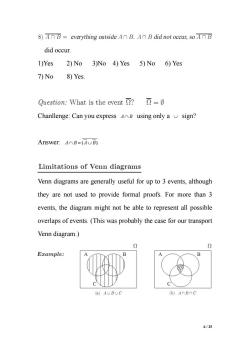
8)AnB=everything outside An B.An B did not occur,soanB did occur. 1)Yes 2)No 3)No 4)Yes 5)No 6)Yes 7)No 8)Yes Question:What is the event ?=0 Chanllenge:Can you express B using only a sign? Answer:A0B=(B). Limitations of Venn diagrams Venn diagrams are generally useful for up to 3 events,although they are not used to provide formal proofs.For more than 3 events,the diagram might not be able to represent all possible overlaps of events.(This was probably the case for our transport Venn diagram.) Example: (a)AUBUC (b)AnBnc 6125
6 / 25 did occur. 1)Yes 2) No 3)No 4) Yes 5) No 6) Yes 7) No 8) Yes. Chanllenge: Can you express A∩ B using only a ∪ sign? Answer: A∩ B = (A∪ B). Venn diagrams are generally useful for up to 3 events, although they are not used to provide formal proofs. For more than 3 events, the diagram might not be able to represent all possible overlaps of events. (This was probably the case for our transport Venn diagram.)

Properties of union,intersection,and complement The following properties hold. )万=2and=0. (ii)For any event A, AU万=2, and An万=0 (iii)For any events A and B. AUB BUA, and A∩B=BnA. (iv)(a)(AUB)=AnB. (b)AnB可=AUB () 2 Distributive laws: For any sets A,B,and C: AU(BnC)=(AUB)n(AUC). and An(BUC)=(AnB)U(AnC). More generally,for several events A and B1,B2,...,Bn., 4u(a)-4u (a)-gunm 7125
7 / 25 Properties of union, intersection, and complement The following properties hold. Distributive laws: For any sets A, B, and C:
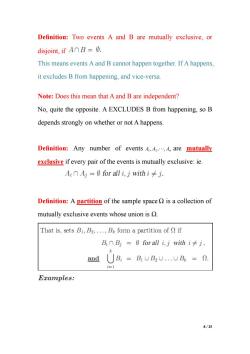
Definition:Two events A and B are mutually exclusive,or disjoint,if AnB=0. This means events A and B cannot happen together.If A happens, it excludes B from happening,and vice-versa Note:Does this mean that A and B are independent? No,quite the opposite.A EXCLUDES B from happening,so B depends strongly on whether or not A happens. Definition:Any number of events 4.4..4 are mutually exclusive if every pair of the events is mutually exclusive:ie. AinA=0 for all i.j withi j. Definition:A partition of the sample space is a collection of mutually exclusive events whose union is That is,sets B,B....B form a partition of if BinBj 0 for all i,j withij, and B:B UB2U...UBk Q. =1 Examples: 8/25
8 / 25 Definition: Two events A and B are mutually exclusive, or disjoint, if This means events A and B cannot happen together. If A happens, it excludes B from happening, and vice-versa. Note: Does this mean that A and B are independent? No, quite the opposite. A EXCLUDES B from happening, so B depends strongly on whether or not A happens. Definition: Any number of events A A An , , , 1 2 are mutually exclusive if every pair of the events is mutually exclusive: ie. Definition: A partition of the sample space Ω is a collection of mutually exclusive events whose union is Ω

B.B2,Bs.B form a partition of: B....B partition B Important:B and B partition for any event B Partitioning an event A If B....B form a partition of,then (AB)....(AB) form a partition of A. 2 B B Bs We will see that this is very useful forfinding the probability of event A. This is because it is often easier to find the probability of small 'chunks'of A (the partitioned sections)than tdind the whole probability of A at once.The partition idea shows us how to add the probabilities of these chunks together:see later 9125
9 / 25 . form a partition of A. We will see that this is very useful for finding the probability of event A. This is because it is often easier to find the probability of small ‘chunks’ of A (the partitioned sections) than to find the whole probability of A at once. The partition idea shows us how to add the probabilities of these chunks together: see later
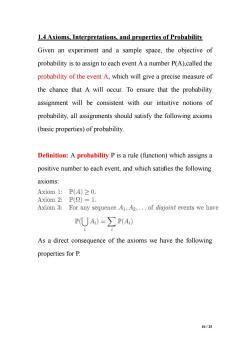
1.4 Axioms,Interpretations,and properties of Probability Given an experiment and a sample space,the objective of probability is to assign to each event A a number P(A).called the probability of the event A,which will give a precise measure of the chance that A will occur.To ensure that the probability assignment will be consistent with our intuitive notions of probability,all assignments should satisfy the following axioms (basic properties)of probability. Definition:A probability P is a rule(function)which assigns a positive number to each event,and which satisfies the following axioms: Axiom1:P(A)≥0. Axiom 2: P(2)=1. Axiom 3:For any sequence A1,A2,...of disjoint events we have PUA)=∑P(A) As a direct consequence of the axioms we have the following properties for P. 10/25
10 / 25 1.4 Axioms, Interpretations, and properties of Probability Given an experiment and a sample space, the objective of probability is to assign to each event A a number P(A),called the probability of the event A, which will give a precise measure of the chance that A will occur. To ensure that the probability assignment will be consistent with our intuitive notions of probability, all assignments should satisfy the following axioms (basic properties) of probability. Definition: A probability P is a rule (function) which assigns a positive number to each event, and which satisfies the following axioms: As a direct consequence of the axioms we have the following properties for P
按次数下载不扣除下载券;
注册用户24小时内重复下载只扣除一次;
顺序:VIP每日次数-->可用次数-->下载券;
- 《概率论与数理统计》课程教学资源(教案讲义)概率论与数理统计教学大纲.pdf
- 《实分析与傅里叶分析》课程教学资源(讲义)实分析与傅里叶分析(英文版)Introduction to Real Analysis and Fourier Analysis,RA.pdf
- 《高等数学》课程教学资源(书籍文献)高等数学参考书籍《古今数学思想》电子版(2/4)第二册.pdf
- 《高等数学》课程教学资源(书籍文献)高等数学参考书籍《古今数学思想》电子版(4/4)第四册.pdf
- 《高等数学》课程教学资源(书籍文献)高等数学参考书籍《古今数学思想》电子版(3/4)第三册.pdf
- 《高等数学》课程教学资源(书籍文献)高等数学参考书籍《古今数学思想》电子版(1/4)第一册.pdf
- 微积分发展史(讲义)微积分思想的产生与发展历史.pdf
- 上海交通大学:《概率论与数理统计》课程教学资源(课件讲义)第八章 假设检验 8.2 单个正态总体的参数检验.pdf
- 上海交通大学:《概率论与数理统计》课程教学资源(课件讲义)第八章 假设检验 8.1 假设检验的基本概念.pdf
- 上海交通大学:《概率论与数理统计》课程教学资源(课件讲义)第七章 参数估计 7.3 区间估计.pdf
- 上海交通大学:《概率论与数理统计》课程教学资源(课件讲义)第七章 参数估计 7.2 点估计的评价标准.pdf
- 上海交通大学:《概率论与数理统计》课程教学资源(课件讲义)第七章 参数估计 7.1 点估计法.pdf
- 上海交通大学:《概率论与数理统计》课程教学资源(课件讲义)第六章 数理统计的基本概念 6.2 抽样分布.pdf
- 上海交通大学:《概率论与数理统计》课程教学资源(课件讲义)第六章 数理统计的基本概念 6.1 基本概念.pdf
- 上海交通大学:《概率论与数理统计》课程教学资源(课件讲义)第五章 大数定律与中心极限定理 5.2 中心极限定理.pdf
- 上海交通大学:《概率论与数理统计》课程教学资源(课件讲义)第五章 大数定律与中心极限定理 5.1 大数定律.pdf
- 上海交通大学:《概率论与数理统计》课程教学资源(课件讲义)第四章 随机变量的数字特征 4.4 矩和协方差矩阵.pdf
- 上海交通大学:《概率论与数理统计》课程教学资源(课件讲义)第四章 随机变量的数字特征 4.3 协方差及相关系数.pdf
- 上海交通大学:《概率论与数理统计》课程教学资源(课件讲义)第四章 随机变量的数字特征 4.2 方差.pdf
- 上海交通大学:《概率论与数理统计》课程教学资源(课件讲义)第四章 随机变量的数字特征 4.1 数学期望.pdf
- 《概率论与数理统计》课程教学资源(教案讲义)Chapter 2 Conditional Probability.pdf
- 《数理统计》课程PPT教学课件(讲稿)离散随机变量及分布律.ppt
- 《数理统计》课程PPT教学课件(讲稿)常见的连续性随机变量的分布.ppt
- 《数理统计》课程PPT教学课件(讲稿)第一章 统计推断准备.ppt
- 《线性代数》课程教学资源(书籍文献)线性椭圆型方程 Linear Elliptic Equations.pdf
- 上海交通大学:《矩阵论》课程教学资源(讲义)CHAPTER 00.pdf
- 上海交通大学:《矩阵论》课程教学资源(讲义)CHAPTER 01.pdf
- 上海交通大学:《矩阵论》课程教学资源(讲义)CHAPTER 02.pdf
- 上海交通大学:《矩阵论》课程教学资源(讲义)CHAPTER 03.pdf
- 上海交通大学:《矩阵论》课程教学资源(讲义)CHAPTER 04.pdf
- 上海交通大学:《矩阵论》课程教学资源(讲义)CHAPTER 05.pdf
- 上海交通大学:《矩阵论》课程教学资源(讲义)CHAPTER 06.pdf
- 上海交通大学:《矩阵论》课程教学资源(讲义)CHAPTER 07.pdf
- 上海交通大学:《矩阵论》课程教学资源(讲义)CHAPTER 08.pdf
- 概率论与数理统计课程教学大纲 Probability and statistics.pdf
- 延安大学:《概率论与数理统计》课程授课教案(打印版)概率论与数理统计 Probability Theory and Mathematical Statistics(任课教师:吕佳).pdf
- 西北师范大学:数学与统计学院数学与应用数学专业学院平台学科必修课程教学大纲汇编.pdf
- 西北师范大学:数学与统计学院数学与应用数学专业专业平台必修课程教学大纲汇编.pdf
- 西北师范大学:数学与统计学院数学与应用数学专业专业平台任选课程教学大纲汇编.pdf
- 西北师范大学:数学与统计学院信息与计算科学专业专业平台必修课程教学大纲汇编.pdf
